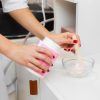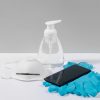- Empty cart.
- Continue Shopping
How to Choose the Right Disinfectant for Effective Homecare

In a world with constant exposure to harmful bacteria and viruses, keeping a house clean and sanitized is not merely a matter of being organized but also of providing an environment that keeps healthy, safe, and sound people together. Whether it is disassembling surfaces after meals have been prepared, washed areas after pets have brought grime into the homes or simply keeping the whole space fresh, the key thing is to select right antiseptic disinfectants to bring effective home care into action.
Here, let’s explore the essential factors to consider when selecting a disinfectant, the types available, and their suitability for different areas in your home.
Understanding Disinfectants and Their Importance
These are chemicals that kill or hinder the growth of any type of microorganisms: bacteria, viruses, fungi, and so on. Now, cleaning is meant to remove dirt and grime from surfaces, but disinfecting kills off nasty germs. This, therefore, is very essential in houses that are so trafficked or where people spend much time touching surfaces as they go about their business. This includes kitchens, bathrooms, and living rooms.
There are many disinfectants, but one of the most popular for household use is antiseptic disinfectant. It is known to clean and sanitize surfaces in a gentle yet effective way. Antiseptic disinfectants are formulated safe for use on the skin and non-toxic. They are thus ideal for homes with children or pets..
-
Types of Disinfectants
To choose the right disinfectant, it’s essential to recognize the types available and how each works. Some common disinfectant types include:
- Alcohol-based disinfectants: These are commonly found in hand sanitisers and other surface cleaners, and ethanol-based disinfectants are generally effective against a wide range of bacteria and viruses. The effectiveness drops with organic matter or dilution.
- Bleach-based disinfectants: Bleach is a powerful disinfectant that kills bacteria, viruses, and fungi. However, it is very corrosive and can damage many surfaces and irritate the skin.
- Antiseptic disinfectants: Antiseptics disinfectants, which are more mild that could be used on either surfaces or skin, are their reason for suitability in handling minor cuts or cleaning any surfaces that have come into direct contact with food.
- Quaternary ammonium compounds (Quats): These compounds are mostly used in hospitals; they display excellent activity against a wide spectrum of pathogens but care needs to be exercised using it around the presence of pets and small children.
A disinfectant that one chooses to use in their home should be one that addresses the need for both surface and personal hygiene. An antiseptic disinfectant would be good.
Key Factors to Consider When Choosing a Disinfectant
a) Spectrum of Activity
Not all disinfectants are effective against all forms of microorganisms. They can be specific to the targeted bacteria or may have strong activity against viruses and fungi. For complete home care, select a broad spectrum of activity disinfectant; it should be active towards bacteria, viruses, and fungi.
b) Safety and Toxicity
Safety is the paramount concern, especially in houses with children or pets. Some disinfectants are made with extremely harsh chemicals that can cause health problems when they come into contact with the skin or by inhalation. An antiseptic disinfectant is a great choice for families because it is relatively non-toxic, harmless to the skin, and unlikely to cause irritation or respiratory problems.
c) Application and Ease of Use
Consider how convenient it is to apply the disinfectant. Some come in sprays, while others come as wipes; and still, others are in liquid form that needs to be diluted. Choose what best fits your lifestyle and can be applied on a daily basis. For example, a spray antiseptic disinfectant would be very easy and quick to apply to high-touch surfaces and wipes would be ideal for cleaning when one is always on the go.
d) Surface Compatibility
Different surfaces require different disinfecting agents. Bleach-based disinfectants, for example, may damage wood or upholstery, while alcohol-based disinfectants may not be effective on porous surfaces. Antiseptic disinfectants, because of their gentle formulation, are compatible with a broader range of surfaces, from countertops to toys and doorknobs.
e) Contact Time
Contact time is how long a disinfectant must remain on a surface before it kills the germs. It can be very variable; some require only one minute, but others may require as much as 10 minutes. To make daily cleaning easier, select a disinfectant with shorter contact time.
Advantages of Antiseptic Disinfectants in Homecare
An antiseptic disinfectant is a versatile and effective choice for households. Here are some notable advantages:
- Gentle on Skin and Safe for All Ages: The antiseptic disinfectants are safe for use on human skin. It is ideal for children and the elderly in the house.
- Multi-Surface Application: While some chemicals may be very harsh and damage or stain surfaces, antiseptic disinfectants are normally safe to use on countertops, toys, and even fabrics.
- Dual-Purpose Use: The antiseptic disinfectants can be used both for surface cleaning and as antiseptic medication in the initial first-aid, thus suitable even for minor cuts or skin abrasions to be treated simultaneously with disinfecting the surface.
Common Ingredients in Disinfectants and Their Efficacy
Knowing the ingredients in your disinfectant can give you a better understanding of its efficacy and safety. Here are a few common ones:
- Hydrogen Peroxide: Often used in antiseptic disinfectants, hydrogen peroxide is effective against a wide range of microorganisms and is less harmful to the environment compared to bleach.
- Isopropyl Alcohol: An effective disinfectant for bacteria and viruses, isopropyl alcohol is commonly used in hand sanitizers and surface disinfectants but is not effective on all pathogens, such as bacterial spores.
- Chlorhexidine: This is a common ingredient in antiseptic products and has a residual effect, meaning it continues to disinfect even after initial use.
- Quaternary Ammonium Compounds (Quats): Effective against a broad range of pathogens, Quats are used in many disinfectants but are not typically skin-friendly.
-
How to Use Antiseptic Disinfectants for Effective Homecare
To maximize the effectiveness of antiseptic disinfectants, it’s essential to follow proper procedures:
- Clean Surfaces First: Disinfectants are most effective when applied to clean surfaces. Remove visible dirt and grime using soap and water before disinfecting.
- Read the Label for Dilution Instructions: Some antiseptic disinfectants come in concentrated forms and need to be diluted. Always follow the instructions to ensure efficacy without causing damage to surfaces.
- Apply Generously and Evenly: Ensure that the surface is thoroughly covered. Spray or wipe the surface, making sure it is damp but not overly saturated.
- Allow Proper Contact Time: As mentioned, the disinfectant needs time to work. Avoid wiping it off immediately, and follow the instructions on the label to ensure it remains on the surface for the required duration.
- Safe Storage and Disposal: Store disinfectants in a cool, dry place out of reach of children and pets. Dispose of empty containers according to the manufacturer’s instructions to prevent environmental contamination.
-
Disinfecting High-Touch Areas in Your Home
Certain areas in your home are more prone to harboring germs due to frequent contact. Using an antiseptic disinfectant in these areas can significantly reduce the risk of illness.
- Door Handles and Light Switches: These surfaces are touched multiple times a day, making them prime spots for germs to accumulate. A quick wipe-down with an antiseptic disinfectant can keep them germ-free.
- Kitchen Counters and Cutting Boards: Food preparation areas require regular disinfection, as they can host bacteria from raw foods. Opt for a food-safe antiseptic disinfectant in these areas.
- Electronics and Remote Controls: These items are often overlooked but can accumulate a lot of germs. Ensure the disinfectant you choose is suitable for use on electronics to avoid damage.
-
Avoiding Common Disinfectant Mistakes
When it comes to disinfecting, a few common mistakes can reduce effectiveness or cause unintended harm. Here are some to avoid:
- Mixing Disinfectants: Mixing different disinfectants, such as bleach with ammonia, can create toxic fumes. Always use one product at a time and read the label for safe usage.
- Not Following Contact Time: Wiping away the disinfectant too soon may leave germs on the surface. Give the disinfectant time to work.
- Overusing Disinfectants on Skin: Even antiseptic disinfectants should be used in moderation on the skin. Overuse can lead to dryness or irritation.
Choosing Environmentally Friendly Options
This market has increased with awareness and concern regarding the environmental effect. Search for products that contain such natural ingredients as plant-based alcohols, essential oils, or citric acid; the products would be effective with less harm to the environment. The many antiseptic disinfectants are good examples since they tend to be relatively weak, biodegradable active ingredients.
Conclusion
To effectively choose the right disinfectant for your home is not only to eliminate the germs but also the balance between effectiveness, safety, and convenience. Good antiseptic disinfectants offer a great choice for families as they present both germ-killing powers and gentle safety for repeated use. With knowledge about the types of disinfectants, reading labels, and following best practices, you can maintain your house as a clean, healthy space for everyone.





